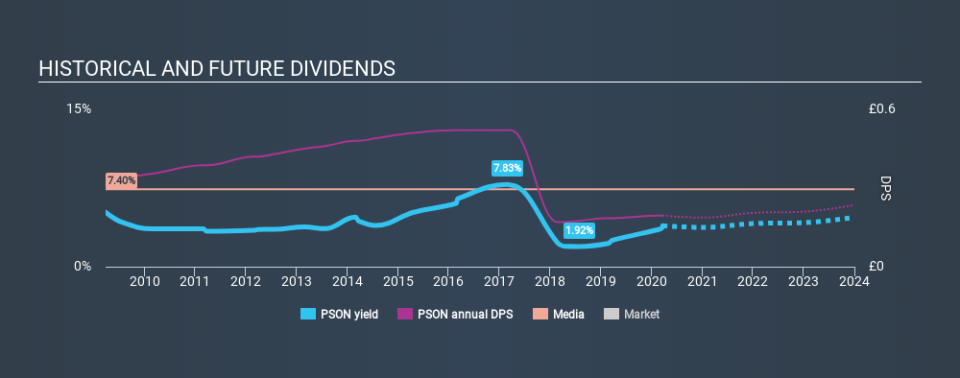Just 4 Days Before Pearson plc (LON:PSON) Will Be Trading Ex-Dividend

Readers hoping to buy Pearson plc (LON:PSON) for its dividend will need to make their move shortly, as the stock is about to trade ex-dividend. Ex-dividend means that investors that purchase the stock on or after the 26th of March will not receive this dividend, which will be paid on the 7th of May.
Pearson's next dividend payment will be UK£0.14 per share, on the back of last year when the company paid a total of UK£0.20 to shareholders. Based on the last year's worth of payments, Pearson stock has a trailing yield of around 3.9% on the current share price of £4.996. We love seeing companies pay a dividend, but it's also important to be sure that laying the golden eggs isn't going to kill our golden goose! As a result, readers should always check whether Pearson has been able to grow its dividends, or if the dividend might be cut.
Check out our latest analysis for Pearson
Dividends are typically paid from company earnings. If a company pays more in dividends than it earned in profit, then the dividend could be unsustainable. Pearson paid out 57% of its earnings to investors last year, a normal payout level for most businesses. Yet cash flows are even more important than profits for assessing a dividend, so we need to see if the company generated enough cash to pay its distribution. Over the last year, it paid out more than three-quarters (84%) of its free cash flow generated, which is fairly high and may be starting to limit reinvestment in the business.
It's encouraging to see that the dividend is covered by both profit and cash flow. This generally suggests the dividend is sustainable, as long as earnings don't drop precipitously.
Click here to see the company's payout ratio, plus analyst estimates of its future dividends.
Have Earnings And Dividends Been Growing?
Stocks in companies that generate sustainable earnings growth often make the best dividend prospects, as it is easier to lift the dividend when earnings are rising. If earnings fall far enough, the company could be forced to cut its dividend. This is why it's a relief to see Pearson earnings per share are up 6.6% per annum over the last five years. While earnings have been growing at a credible rate, the company is paying out a majority of its earnings to shareholders. If management lifts the payout ratio further, we'd take this as a tacit signal that the company's growth prospects are slowing.
The main way most investors will assess a company's dividend prospects is by checking the historical rate of dividend growth. Pearson's dividend payments per share have declined at 5.4% per year on average over the past ten years, which is uninspiring. It's unusual to see earnings per share increasing at the same time as dividends per share have been in decline. We'd hope it's because the company is reinvesting heavily in its business, but it could also suggest business is lumpy.
Final Takeaway
From a dividend perspective, should investors buy or avoid Pearson? Earnings per share have been growing modestly and Pearson paid out a bit over half of its earnings and free cash flow last year. In summary, it's hard to get excited about Pearson from a dividend perspective.
If you're not too concerned about Pearson's ability to pay dividends, you should still be mindful of some of the other risks that this business faces. For example, Pearson has 4 warning signs (and 1 which can't be ignored) we think you should know about.
A common investment mistake is buying the first interesting stock you see. Here you can find a list of promising dividend stocks with a greater than 2% yield and an upcoming dividend.
If you spot an error that warrants correction, please contact the editor at editorial-team@simplywallst.com. This article by Simply Wall St is general in nature. It does not constitute a recommendation to buy or sell any stock, and does not take account of your objectives, or your financial situation. Simply Wall St has no position in the stocks mentioned.
We aim to bring you long-term focused research analysis driven by fundamental data. Note that our analysis may not factor in the latest price-sensitive company announcements or qualitative material. Thank you for reading.

 Yahoo Finance
Yahoo Finance 
